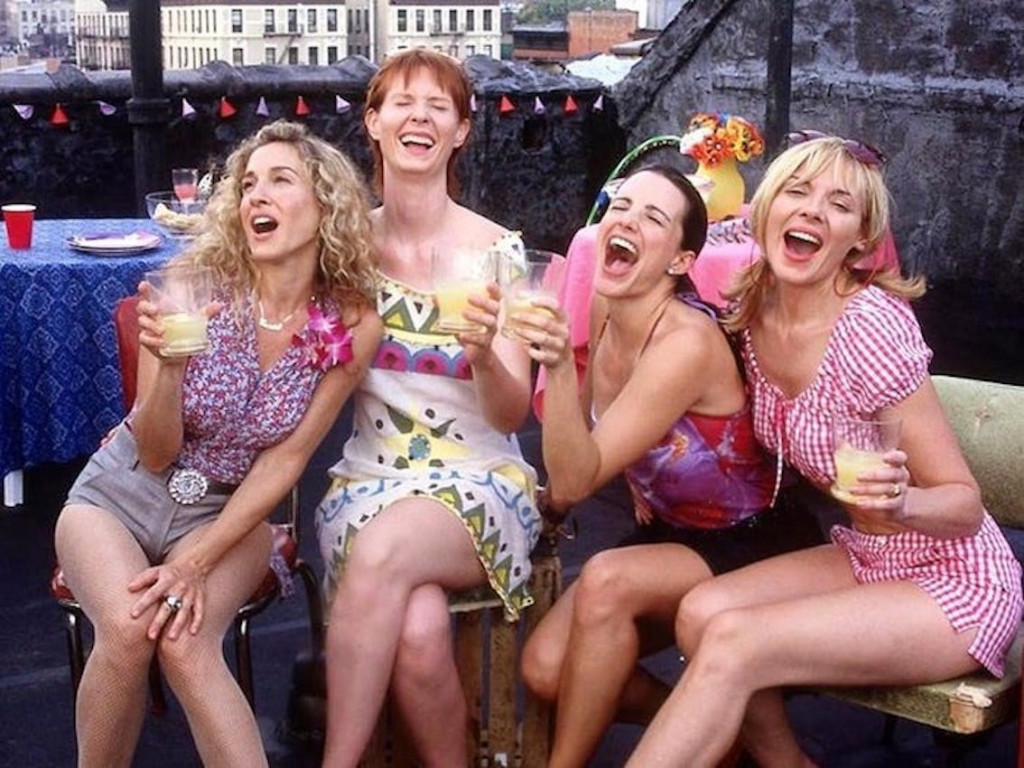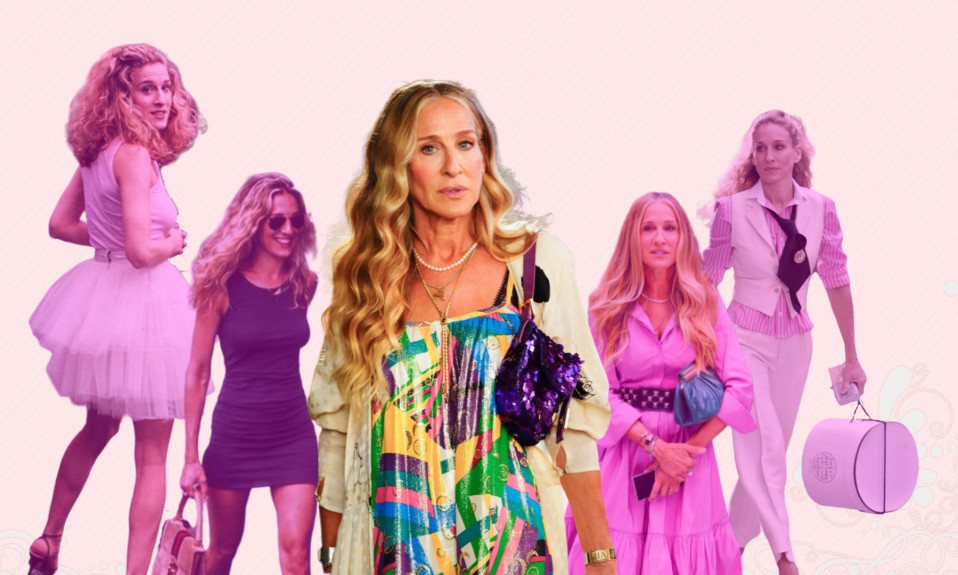The first episode of Sex and the City begins strangely. We hear the voice of a woman, American and playful, describe a courtship between a female English journalist and a male Wall Street banker who met at an art gallery. At first, it’s as romantic as you might expect; they have passionate sex, they start looking at apartments together, and he asks her to meet his parents. Then, there is a turn. His parents can’t make it to their dinner. Can they rain check? Two weeks pass, and she still hasn’t heard from him, so she finds herself sitting in a diner in front of an elusive figure, complaining that the man she thought she loved is a total pig. This figure, wearing a trench coat and holding a cigarette, looks almost like they’ve stepped out of a film noir, a sort of femme fatale detective looking for answers. This is Carrie Bradshaw, a journalist searching for inspiration for her weekly column about sex and love.
Then Carrie begins her famous opening monologue, with reference to Edith Warton’s classic American novel: ‘Welcome to the age of un-innocence’. We see Carrie’s face for the first time, played with an almost bristling edginess by Sarah Jessica Parker, as she types at her desk, smoking, face lit by a neon sign outside. She continues: ‘No one has Breakfast at Tiffany’s, and no one has Affairs to Remember. Instead, we have breakfast at 7AM and affairs we try to forget as quickly as possible.’

In this opening, Sex and the City sets out its mission statement. It aims to deconstruct the idea of romance and to break down what is real and what is fantasy, what we tell ourselves we want and why we want it. In each episode, Carrie will try to unpack a new question using her own experience and that of her friends Charlotte, Samantha, and Miranda – all of whom often represent different schools of thought. Charlotte is more traditional, with a strong belief in love; Miranda is more level-headed and often cynical about what she’s supposed to want; and Samantha bucks all traditional ideas in favour of a life lived in pursuit of pleasure. Meanwhile Carrie, throughout the show’s run, oscillates between these positions, trying to make sense of a world that is getting crazier and crazier.
It’s this dissection that gave the show its legacy. For six years, the four women sat around a table in a coffee shop or restaurant and discussed the pros and cons of giving head, what kind of power games are at play when it comes to anal sex, whether married couples see single people as a threat, and all other types of societal pressures. As someone who first watched Sex and the City in high school, as a queer person who was having no sex or romance, it took up a special place in my heart. I’ve had a practically unshakeable obsession with it ever since, and Carrie has always been at its centre.
So, I got to thinking about Carrie Bradshaw. Over the past week or so, I have become obsessed with the on-set photos that kept emerging from the Sex and the City reboot, And Just Like That, which is currently filming in New York. Carrie, Charlotte and Miranda are back on the streets, meeting in coffee bars or outside museums to discuss the woes of their fifties. And I couldn’t help but wonder; where is Carrie now, and is she still a mess?

I use “mess” in the most loving of ways because I am the same kind of mess. To me, the show’s protagonist is a stark reflection of all the hang-ups I have in terms of insecurity, vulnerability, and attitude. Not to mention, despite the ruthless “Carrie-Bashing” that’s become in vogue, I still see her as one of the greatest characters in American television history – a more realistic version of the anti-hero trope we hear about in relation to numerable male characters.
The more I re-watch the show the more I realise that Carrie’s arc – that of a woman broken down by the classic idea of love – is the best example of the show’s mission statement. Carrie is a cool, collected, and confident sex columnist who acts as a sexual anthropologist in that opening episode. She’s reached a point in her life where she’s emotionally stable, having sex with exes and getting her face plastered on the side of a bus, but when Mr Big enters the frame, that all begins to unravel. She finds herself changing, worrying he won’t like the person she is. Instead, she presents the ‘together Carrie’ that means her emotional outbursts, in response to his repression, come off as unhinged or left-field. The show to me is about how one woman loses herself by craving the love of a man she isn’t meant to be with. It is not, as some think, a great romance, but actually closer to a six season-long fuck-up.
What strikes me as most interesting is how the show’s finale, in which Mr Big and Carrie reunite in a classical romantic fashion in Paris, was not the original intention. The show’s creator, Darren Star, who handed the series over to Michael Patrick King during its run, said the ending betrayed his original feminist vision, “which was that women don’t ultimately find happiness from marriage”. Elsewhere, Emily Nussbaum, whose interpretation of the show comes closest to my own, thought the ending didn’t work either. She wrote:
“And then, in the final round, “Sex and the City” pulled its punches, and let Big rescue Carrie. It honored the wishes of its heroine, and at least half of the audience, and it gave us a very memorable dress, too. But it also showed a failure of nerve, an inability of the writers to imagine, or to trust themselves to portray, any other kind of ending—happy or not. And I can’t help but wonder: What would the show look like without that finale?”
This is not to say that the final season has no merit. In fact, it’s the opposite. Nussbaum points out that Carrie’s relationship with an emotionally cold Russian artist serves as an example of just how much the pursuit of a fairytale can leave you in the lurch. The fifteenth episode in season six, ‘Catch-38’, is one of the strongest, as Carrie reconciles the fact that the Russian doesn’t want kids and she isn’t sure she does either. Ultimately, her decision to forgo children remains radical today.

Now, perhaps, with the reboot, the writers are beginning to course correct. According to Page Six, rumour has it that the new show will see Carrie and Mr Big in the (POTENTIAL SPOILER ALERT!) throes of a divorce, perhaps realising what half the audience already knew; they’re not right for each other. Maybe now we’ll see the show – under its new name – return to its original intention after getting slightly lost in the glitz and glamour of the movies.
This might all just be my wishful thinking. The idea of Carrie, presented as “the last single girl”, has always been meaningful to me, and the idea that she might now be facing the ramifications of her poor decisions when it comes to Big – much like me, who is still very much fucked up by my first love – would place a beloved character I care for back in my orbit. Either way, am I ready for more Carrie Bradshaw in any capacity? Abso-fucking-lutely.
Also Read:












